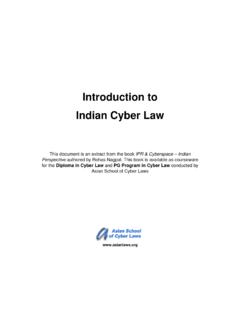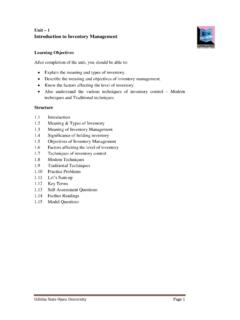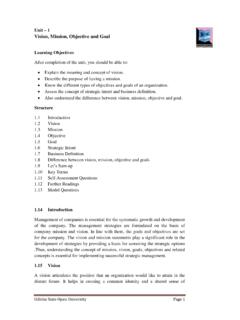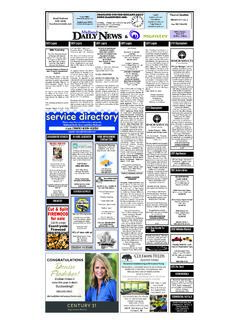Transcription of Role of Media in Disaster Management
1 Role of Media in Disaster Management Dr R K Dave , , , Senior Specialist (Polices & Plans), National Disaster Management Authority Government of India INTRODUCTION: The Media forges a direct link between the public and emergency organizations and plays a very important role in disseminating vital information to the public before, during and after disasters. The Media assists in the Management of disasters by educating the public about disasters; warning of hazards; gathering and transmitting information about affected areas; alerting government officials, relief organizations and the public to specific needs; and facilitating discussions about Disaster preparedness and response for continuous improvement. To help the Media fulfil these roles, direct and effective working relationships between the Media and Disaster Management organizations should be established and maintained.
2 Experience shows that regular interactions with the Media before a Disaster strikes, aids the effective flow of information and lays the groundwork for effective working relationships in the aftermath of a Disaster . Media AND emergency RESPONSE A REVIEW: In managing Disaster - the necessity of right information at right time has not changed for centuries. People need warnings ahead of the Disaster and then, in its aftermath, data on - casualties, damage, the supplies and skills that are needed, the best ways to bring in these resources, the help that is available and is being provided, and so on. There are many examples where - public education and the rapid, widespread dissemination of early warnings saved thousands of lives. In November 1970, for example, a tropical cyclone, combined with a high tide, struck southeastern Bangladesh, leaving more than 300,000 people dead and million homeless.
3 In May 1985, a comparable cyclone and storm surge hit the same area. "This time - there was better local dissemination of Disaster warnings and the people were better prepared to respond to them. The loss of life, although still high, was 10,000 or about 3 percent of that in 1970. When a devastating cyclone struck the same area of Bangladesh in May 1994, fewer than 1,000 people died. 1977 cyclone in Andra Pradesh, India killed 10,000 people, while a similar storm in the same area 13 years later killed only 910. The dramatic difference - was due to the fact that a new early-warning system connected with radio stations to alert people in low-lying areas, was put into place. On the other side there are many examples where absence of an alert and warning system resulted into huge number of casualties and extensive damage of property. Bhopal gas leak, 1999 super cyclone in Orissa and 2004 Indian Ocean tsunami are few of the recent example in India where timely alert could have saved millions of lives and enormous property.
4 These and many other examples make it clear that Media , with its instantaneous outreach, throughout the world play a vital role in educating the public about disasters; warning of hazards; gathering and transmitting information about affected areas; alerting government officials, relief organizations, and the public to specific needs; and facilitating discussions about Disaster preparedness and response. The Media can assist in pre- Disaster education. They may be crucial to an effective warning process. They can provide information and advice to victims and others in the wake of disasters. They can help activate the local Disaster response. They can assist in stimulating effective Disaster relief. All this is not to say the Media do not, on occasion, cause problems. They can help increase convergence to the scene both by the curious and by those with genuine concerns.
5 By their own convergence, both in person and by telephone, they can create pressures on managers for information to the point where Media demands interfere with effective response.' They can spread rumors,' and so alter the reality of Disaster , at least to those well away from it, that they can bias the nature of the response." They can and do create myths about disasters, myths which will persist even among those with contrary Disaster experience. Public administrators sometimes decry the mass Media . They see a more relaxed working atmosphere if the Media were not there to record their actions, question their decisions, and air the remarks of their critics. But in time of Disaster the Media , on balance, are actually helpful. Rather, their absence can create enormous difficulties. In addition, Media can be a way in which individuals or organizations can ask for information.
6 While the Media cannot usually have answers to public queries directly (though they may try to do so), they can be a link between the public and the central / state Disaster Management authority. There are examples when Media (a radio station) helped mobilize relief and in mobilizing effective emergency response. TECHNOLOGY IN Media : There are two major types of Media that exists 1. Electronic Media and 2. Print Media . Radio, (both satellite as well as wireless), and Television (cable, DTH etc) are prominent player in electronic Media , where as newspapers, magazines, journals are part of the print Media . Technology has a crucial role in information acquisition, analysis, forecasting and dissemination. New technological advances in communications offer the prospect of considerable improvement, both in the anticipation of sudden-onset Disaster , and in dealing with after-effects once Disaster occurs.
7 Communication underlies virtually all elements of the hazard-mitigation process. The capabilities of communications, data-gathering, and data- Management technology have leaped forward in parallel with our increasing knowledge about the origins and behavior of natural hazards and the mitigation of their effects. Indeed, advances in telecommunications and computer sciences are among the major contributors to the recognition that technology can do much to blunt the effects of natural hazards. In meteorology, the deployment of geosynchronous satellites for telecommunications and for Earth observation, combined with the use of supercomputers to analyze the data gathered from space, has led to highly sophisticated models of tropical storm formation and behavior, providing earlier and far more reliable information with which to plan evacuations and other hazard-mitigation strategies.
8 Similarly, remote sensing from space can now identify insect infestations by detecting changes in the color of the Earth's surface. Seismological devices, also linked to supercomputers, are greatly improving our understanding of earthquake propagation. The hope is that this increased knowledge will enable us, in time, to provide reasonably early warnings about earthquakes in the same way as we can increasingly do so for volcanic eruptions, tsunamis, and various meteorological events. Table-I: Linkages between Communication Technology and Management of Various Classes of Hazards Hazards Satellite Sensors Satellite Remote Telemetry Radio and TV Print Media Terrestrial Sensors EARTHQUAKE Linking sensors to central facility and reverse Transmitting warning and protection information / data Education for protection, including evacuation and building techniques Strain gauges vibration sensors LANDSLIDES Meteorological monitoring of soil wetness Transmitting data to central facility and reverse Transmitting warning and protection information / data Education for protection, including evacuation and building techniques Strain gauges wetness sensors TSUNAMIS Wave surge detection Transmitting data to central facility and reverse Transmitting warning and protection information / data Education for protection.
9 Including evacuation and building techniques Subsea vibration sensors VALCANOS Optical and thermal sensors Transmitting data to central facility and reverse Transmitting warning and protection information / data Education for protection, including evacuation and location techniques Vibration and thermal sensors FLOODS Optical Monitoring and meteorology Transmitting data to central facility and reverse Transmitting warnings and protection data Education for protection, including evacuation and location techniques Flow, rain and river high sensors CYCLONES Meteorology Transmitting data to central facility and reverse Transmitting warnings and protection data Education for protection, including evacuation, and construction location techniques Meteorological monitoring for storm surge WILDFIRES Optical and thermal monitoring Transmitting data to central facility and reverse Transmitting warnings and protection data Education for protection, including Prevention and resistant construction Optical and thermal sensor to support visual siting In Japan (one of the most frequently struck countries by earthquakes and tsunamis), reported earthquakes are broadcasted on television within 30 seconds of the event, and dependent on the nature of the earthquake, tsunami warnings can follow very rapidly.
10 For this, the Japan Meteorological Agency has well-coordinated working procedures with the Japan Broadcasting system (NHK) that automatically and seamlessly insert earthquake and tsunami information upon receipt from the warning centre. A major tsunami warning was issued by the Japan Meteorological Agency (JMA) within 3 minutes of 11 March 2011 Tsunami, but the initial warning underestimated the size of the tsunami. JMA subsequently updated the warnings, however in some locations public communication systems were damaged by the earthquake hindering dissemination. Knowledge can be life saving, especially in an emergency , and much of what people know is learnt through the mass Media . With the most advanced tsunami warning system in the world, Japan is a global standard setter. But with the death toll of the March 2011 tsunami nearing 20,000, it is also at the forefront of reflections on how to improve risk preparedness.














